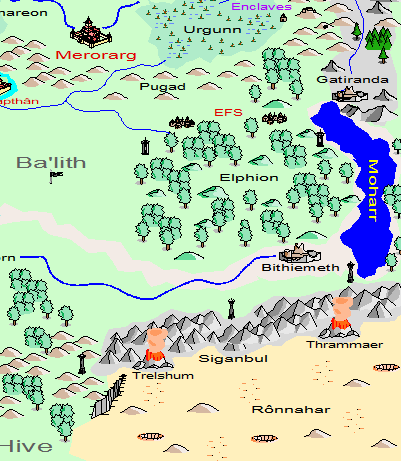
| Category | Ruins | ||||||
| Continent | Karterus | ||||||
| Region | Azrik | ||||||
| Population | |||||||
| Races |
| ||||||
| Founded | 14 Saunas 110 HE | ||||||
| Map | Vetoubahr |
Sited at the southern tip of the Moredhel Valley, Gatiranda began as a mining hold, protecting the interests of Merorarg's merchants. It's wealth came from logging, mining, and shipping these goods back to Merorarg. In 1211 HE, Gatiranda ceded from Merorarg control, becoming an independent city-state. This was a bloodless cession since the head of the mercantile boards of each city were also the de-facto leaders of government. This was because 80% of the money that kept the government running came from commerce. The two leaders settled on a split by binding their two families in marriage; and as was tradition they took the daughter's last name Farinteen as family name. They did this solely to bring an end to the Alpynan Mercantile Dispute which for five years had damaged the economy with high inflation. Now that Gatiranda and Merorarg were independent of each other, the belligerents of the dispute were forced to settle their affairs in the courts of each city. With Gatiranda now an independent city-state, Merorargian Mercantile Law stipulated that the a newly formed entity must throw out its old charter and replace the old mercantile board (for Gatiranda this was a stacked board of Merorarg sympathizers). The courts ruled that the warring merchants must settle on equal rights of commerce along the Alpynan, thus ending the long-running dispute.
In 339, Gatiranda and Merorarg, then both independent city-states, joined together under the Niratar Theocracy.
When friendly contact was established with Andrithiach, Gatiranda became their main trading partner with timber, mining ores and gemstones being shipped north and in return finished products like furniture, windows, and jewelry heading south from their elven neighbors.
Gatiranda escaped the fate of so many other settlements of the Broken Lands, remaining untouched by the devastation wrought by the Gulibmor Cataclysm (996 - 1203). They could not escape the wrath of the Khazarkar Empire. In the Moredhel War (1000 - 1006), Gatiranda was captured by the Khazkars. As an example to other cities in the region that refused to join the Khazarkar Empire as vassals, it was razed. It is said that several hundred, trapped in the cordon of enemy forces, fled south, throwing themselves in Moharr's frigid waters. It is said the lake's northern shores are haunted by their spirits.
While the Khazarkars remained in control of the area, they prevented re-settlement. As a result, most Gatirandans, citizens of the Niratar Theocracy, became part of the growing Great Exodus (998 - 1017). They went north to Andrithiach and then onward to become refugees of the Cal-Thaoun Dynasty. In refugee camps they waited for passage to the Lands of Purity, Niratar's resettlement site. A few thousand stayed in the region, heading west into the lands of their often hostile neighbors, the minotaurs. Some became slaves, others citizens of the Ba'lith Empire. Others headed for the Azrik's north, joining the Torgilm Confederacy (1475 - 1719).
Gatiranda's half-elves were the product of Tragarans and Kriavfahliil that had long had friendly relations. Not always treated equally, many half-elves ended up living in and around Gatiranda.
Today, the ruins of Gatiranda are home to bandits, monsters, and other predators.